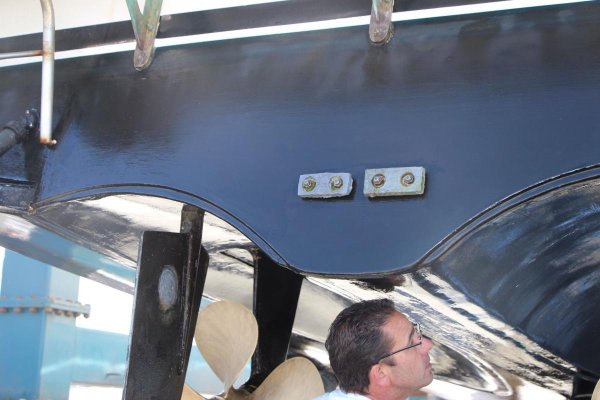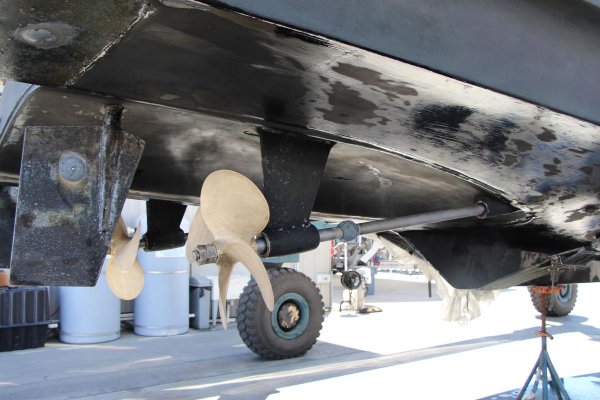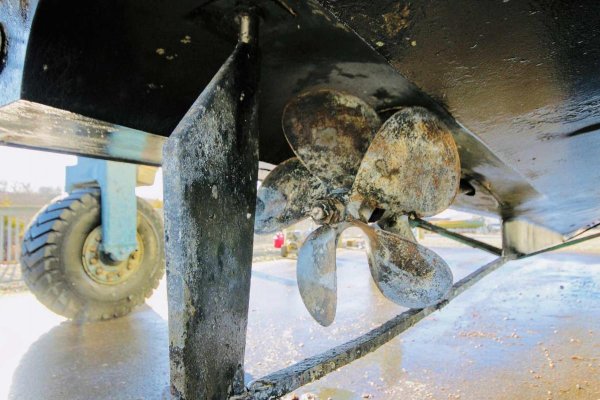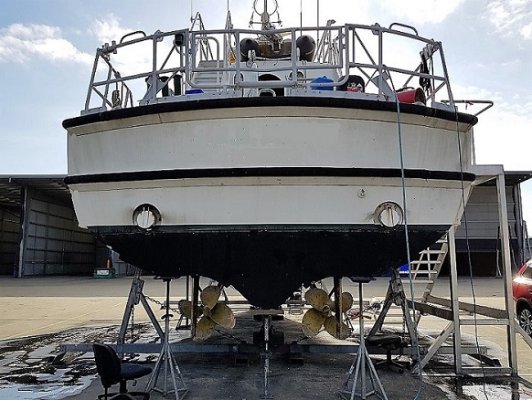You are using an out of date browser. It may not display this or other websites correctly.
You should upgrade or use an alternative browser.
You should upgrade or use an alternative browser.
Prop Pockets/Tunnel Drives
- Thread starter Benthic2
- Start date
The friendliest place on the web for anyone who enjoys boating.
If you have answers, please help by responding to the unanswered posts.
If you have answers, please help by responding to the unanswered posts.
We had them on 3 boats and there were pros and cons....
Good
- "V" struts very stable on ours
- depth clearance
- some prop protection
- better prop angle
Poor
- slightly less efficient
- inability to maneuver as well
- cannot walk the boats stern well at all
I would get one again but I would research the particular vessel and be aware of the limitations.
Good
- "V" struts very stable on ours
- depth clearance
- some prop protection
- better prop angle
Poor
- slightly less efficient
- inability to maneuver as well
- cannot walk the boats stern well at all
I would get one again but I would research the particular vessel and be aware of the limitations.
I had them on two of my last boats: Mainship 34T and Pilot 34. The 34T had no negative issues that I can think of and all of the positives noted above. The Pilot 34 had prop clearance and/or cavitation issues but wasn't so bad.
David
David
psneeld
Guru
on the twins I have operated with them...you definitely needed wheel with split shifting to get a decent turn.
and the reduced dynamic lift on some ay affect top speeds but I had nothing to really compare them to.
and the reduced dynamic lift on some ay affect top speeds but I had nothing to really compare them to.
RT Firefly
Enigma
Greetings,
Mr. B. We have a 23' Penn Yan single with "Tunnel Drive". All of the above comments plus, you're limited to a maximum prop size for appropriate clearance between prop tips and hull. Shallow running is THE plus IMO.
On plane, I'm drawing about 1'.
Sister ship:

Mr. B. We have a 23' Penn Yan single with "Tunnel Drive". All of the above comments plus, you're limited to a maximum prop size for appropriate clearance between prop tips and hull. Shallow running is THE plus IMO.
On plane, I'm drawing about 1'.
Sister ship:
Last edited:
Benthic2
Guru
Thanks everyone!
Ski in NC
Technical Guru
I built a tunnel into my single. No complaints but prop noise is pretty bad from 22kts up to top end of 29-30kts. I just cruise around 18-20kts and noise is not too bad.
Some tunnels are short and water has to make an abrupt change of direction, this increases noise and eats hp. Mine starts gently under the engine, and tunnel is over 10' long.
Some tunnels are short and water has to make an abrupt change of direction, this increases noise and eats hp. Mine starts gently under the engine, and tunnel is over 10' long.
Last edited:
Bkay
Guru
- Joined
- Aug 8, 2018
- Messages
- 580
- Location
- United States
- Vessel Name
- Wingspan
- Vessel Make
- Aluminum Catamaran
I've never spent much time operating boats with tunnels/pockets. But most of the pros and cons mentioned above are consistent with what I've heard from owner/operators. I'll add one more, depending on construction method they can be more expensive due to increased man hours.
ben2go
Guru
An alternative to the tunnel is the Seabright or Higgins style hull. They used a box keel to both lower the engine for a straighter shaft run to the prop and to protect the prop. They are also considered a shoal draft hull. This type hull is not limited to small boats. Higgins used the design on landing craft and other large boats during WWII. Atkins has a lot of stock plans for boats that use this type hull.


I once had a Penn Yan tunnel drive, on Keuka Lake no less.Greetings,
Mr. B. We have a 23' Penn Yan single with "Tunnel Drive". All of the above comments plus, you're limited to a maximum prop size for appropriate clearance between prop tips and hull. Shallow running is THE plus IMO.
On plane, I'm drawing about 1'.
Sister ship:

Codger2
Guru
- Joined
- Oct 11, 2007
- Messages
- 6,691
- Location
- US
- Vessel Name
- Circuit Breaker
- Vessel Make
- 2021..22' Duffy Cuddy cabin
I don't experience that same problem with my tunnels as the props are not mounted close to the top of the tunnel which reduces the constant pounding against the hull that water flying off the blades makes. Also, prop walk is good, for the same reason.IMO they reduce prop walk so that maneuvering is only done by spin not the side thrust possible with an open prop.
I had a 35' Tiara years ago that had tunnels and was a little noisey & needed some help when trying to walk the hull with the prop. I would still buy another "tunneled" hull but only after satisfying myself that the prop blades are sufficiently distant from the hull bottom.
Attachments
I don't experience that same problem with my tunnels as the props are not mounted close to the top of the tunnel which reduces the constant pounding against the hull that water flying off the blades makes. Also, prop walk is good, for the same reason.
I had a 35' Tiara years ago that had tunnels and was a little noisey & needed some help when trying to walk the hull with the prop. I would still buy another "tunneled" hull but only after satisfying myself that the prop blades are sufficiently distant from the hull bottom.
Yes - very shallow tunnels , barely there at all.
High Wire
Guru
My Phoenix 29 had tunnels which had a nasty habit of sucking air on a moderate beam sea. You had to slow down to about 11 knots from a normal 17 cruise in 3-5's. Other than that the plus side was the engines were in the cockpit, out of the cabin. The cabin was much larger than a comparable Bertram 28. Never had any trouble docking as long as both engines were running.
Tamrow
Veteran Member
- Joined
- Jan 17, 2016
- Messages
- 95
- Location
- USA
- Vessel Name
- Chesapeake
- Vessel Make
- Mainship 30 Pilot II
Starting in 2003 the Mainship 30 Pilot ll added a tunnel with a 5 blade prop. It’s nice to bring her in close to shore when anchoring at the beach. Having the tunnel means it has as a fairly short keel so the stern tends to walk a bit in rolling seas. If there is any extra noise due to the blade distance in the tunnel I don’t know as I have nothing to compare it to though I have read the 5 blade minimizes noise and vibration. The original Pilot had a 4 blade prop with a full keel and no tunnel that was known to suffer from vibration due to the distance of the prop to the hull.
Attachments
Adding blades typically reduces vibration by increasing balance, but at the expense of efficiency and drag. The downside of tunnels, is limiting the size of the prop you can fit with an increased need to manage the flow over the prop since you have effects from the tunnel itself. Adding a blade increases surface area without having to further increase the diameter. You can then play with cupping and rake to get the tight flow around the prop until you kill any cavitation picked up along the way.
I once had a Penn Yan tunnel drive, on Keuka Lake no less.
Greetings earthlings. I had a 23 once too. One of the deepest tunnels and I can confidently say that your 23 draws closer to 14 inches, having used that extra couple inches a time or two.
The Penn Yan was a much harder boat to get the prop right than most of the shallower tunnels out there. It does sort of sing when you get it right though.
I once went clean over a log hiding in the chop at around 24 kts without so much as a nick on the prop. Fun boat, but finicky.
cool beans
Senior Member
My 3870 has prop pockets...what I would consider "real" pockets. Sideways motion requires more throttle, but I also have a full length keel. For my size boat, and the horsepower, I think my props are too small. The efficiency (or is it the slip calc?) is something like 60%? But the tunnels don't allow anymore diameter than 20" which is a pretty tiny prop once you get it off the boat. Cummins repowers require something like a 26" pitch since the you can't bump the diameter.
Just my observation.
Just my observation.
My 3870 has prop pockets...what I would consider "real" pockets. Sideways motion requires more throttle, but I also have a full length keel. For my size boat, and the horsepower, I think my props are too small. The efficiency (or is it the slip calc?) is something like 60%? But the tunnels don't allow anymore diameter than 20" which is a pretty tiny prop once you get it off the boat. Cummins repowers require something like a 26" pitch since the you can't bump the diameter.
Just my observation.
A number of the 38's with 175 diesels had 21" diameter props.
But they really do not need to be more than 20" diameter - I would guess that your pitch is in the 21" range as well with 4 blade Nibral props.
Slip is not efficiency but I think your slip calculation is higher than it really is - take into account your actual prop pitch (scanned) your verified rpm and trans ratios at the highest rpm.
You will never get a good slip calculation when the boat is at or near transition speeds.
cool beans
Senior Member
A number of the 38's with 175 diesels had 21" diameter props.
But they really do not need to be more than 20" diameter - I would guess that your pitch is in the 21" range as well with 4 blade Nibral props.
Slip is not efficiency but I think your slip calculation is higher than it really is - take into account your actual prop pitch (scanned) your verified rpm and trans ratios at the highest rpm.
You will never get a good slip calculation when the boat is at or near transition speeds.
Ah, didn't know that! Yes, they were 20x22 nakashima that I had repitched to 20x20. She didn't like getting up on plane. I live aboard and have a lot of crap with me. I also anticipate getting heavier :/
I had my numbers backwards...calc'd slip is like 40%. That's 2800 rpm @ 18 mph. Assuming my tachs are good enough. Starboard engine needs a tune or adjustment. I'll be on the BOF for that though
SpaceCadet
Veteran Member
When Penn Yan boats were popular in the 70's/80's, I used to see them making a very interesting "rooster comb" in the wake when running at higher speed. Not sure what that means...
rgano
Guru
- Joined
- Oct 8, 2007
- Messages
- 5,203
- Location
- Panama City area
- Vessel Name
- FROLIC
- Vessel Make
- Mainship 30 Pilot II since 2015. GB-42 1986-2015. Former Unlimited Tonnage Master
My 30 Pilot II with deep prop tunnel and very close blade tip clearance sounds ike a box of rocks as soon as I hit 1400 RPM on the Yanmar 315 HP, but but 2900 up "on top" there is so much other racket, I no longer notice.
RT Firefly
Enigma
Greetings,
Mr. SC. Yup, rooster tail but at lower (below planing) speed. Even had someone yell at me to lower my outdrive a while back. I yelled back "it's broke".
Mr. SC. Yup, rooster tail but at lower (below planing) speed. Even had someone yell at me to lower my outdrive a while back. I yelled back "it's broke".
FF
Guru
- Joined
- Oct 12, 2007
- Messages
- 22,552
The Seabright box keel with reverse deadrise aft was claimed to be more efficient at SL 2.8 and below .
The boats were beachable or could take the ground at low tide.
A valuable consideration if boating becomes popular again.
The boats were beachable or could take the ground at low tide.
A valuable consideration if boating becomes popular again.
MurrayM
Guru
Dave Gerr designed some real beachable beauties utilizing box keels and tunnel drive hulls:
https://www.gerrmarine.com/Beachable_Boats.html
https://www.gerrmarine.com/Beachable_Boats.html
I bought my second Penn Yan tunnel drive new in 1977 and still own it. Used extensively in Pamlico Sound and the lower Chesapeake mostly for fishing. Truly a tunnel in that the prop barely protrudes beneath the hull, and has minimal clearance on the sides, so it is different from what you would see on a trawler. Mine empty will float in 14 inches of water, and years ago I skied behind it when I could see the ripples in the sand beneath the water (Inexperienced captain). Rudder sits right at the back of the tunnel, and the boat turns sharp as long as going forward, but reverse is largely only a brake. Takes some getting use to but most of the time you can do what you need to by getting the boat swinging and just stopping any forward motion. Never saw any detriment from sucking air and momentary over reving. Noisy yes but I attributed mine to the waterline exhaust. I think they are less fuel efficient, and slower but will put it against anything with regard to maintenance cost and peace of mind underway. Its really hard to beat that 350 GM, coupled to a Velvet Drive and 6-1/2 of straight shaft to a 13x13 largely protected prop. In my case I wanted something that would troll slow, but still make recommended WOT, the 13x13 was stock and worked. Boat is 24 ft, and the fastest she has ever run is about 33mph, and I guess she burns 10 Gph, 2900rpm, 23 mph cruise in calm sea.
Arun52
Veteran Member
I have never experienced any of the negatives mentioned here with tunnels.
All in the design and quality of the build.
No - its actually physics.
mdstrum
Veteran Member
- Joined
- Nov 16, 2017
- Messages
- 85
- Location
- Carlsbad, CA
- Vessel Name
- DESTINY
- Vessel Make
- Bayliner 4588 Extend Hull & Hard Top
Our current boat and 2 of the 3 priors had pockets. I think the every boat handles different and not two are same. I have been on sister ships to our bayliner 4588 over the years and operated a handful and each is different. I think some that has to do with the props being tuned, the idle, the loading of the boat (fuel, water and persona stuff) and pilot.
Personal I prefer the shallow draft and prop protection and do not find the pockets to make the boat hard to handle. ps we do not have thruster and decided during a recent hull extention to not add them, and at this point do not feel they would really add much value as as we can handle the boat with the controls only with wind and current just fine...
just my 2 cents....learning to handle the boat is the most import tool, knowing how she responds and what do to do get the response you want, practice and usage far out weights design and other features as everything becomes a trade off at some point.
Personal I prefer the shallow draft and prop protection and do not find the pockets to make the boat hard to handle. ps we do not have thruster and decided during a recent hull extention to not add them, and at this point do not feel they would really add much value as as we can handle the boat with the controls only with wind and current just fine...
just my 2 cents....learning to handle the boat is the most import tool, knowing how she responds and what do to do get the response you want, practice and usage far out weights design and other features as everything becomes a trade off at some point.
Similar threads
- Replies
- 15
- Views
- 3K
- Replies
- 98
- Views
- 13K








